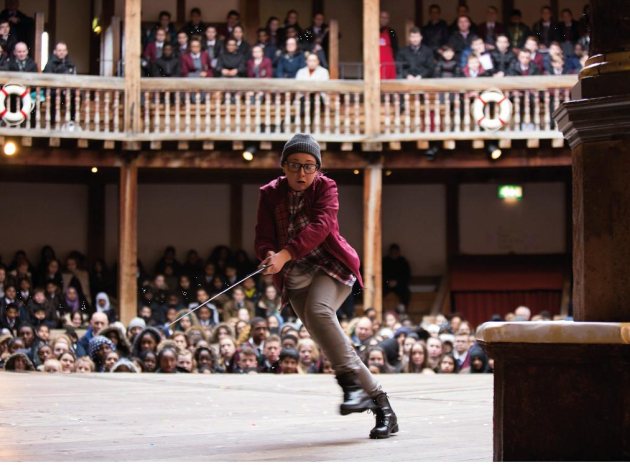Arecent survey by the British Library, based on interviews with 511 secondary school and college teachers of English Language and English Literature, revealed that over 50 percent felt their students found it difficult to connect to or weren’t inspired by Shakespeare’s work. That stark statement does not reflect the wealth of information in the survey which identifies, amongst other things, some key differences across the country in how teachers think their students engage with Shakespeare – rich ground for further investigation, I think.
Like it or not, Shakespeare is there in the secondary curriculum and the first thing teachers have to overcome is their students’ fear of studying his work. The biggest mistake that can be made is to approach Shakespeare as if you are teaching a foreign language, which only serves to deepen students’ misgivings. Shakespeare does not need updating into modern English and the skills used to read and understand his texts are the same ones that are used to read any text. What can help students, particularly lower ability groups, are texts that are skilfully edited to maintain the language and all the key events; play scripts with dynamic stills and insights into productions; a pertinent glossary; classroom activities that encourage them to relate to and empathise with the characters, and, of course, seeing a play performed.
Over 20,000 London and Birmingham students came to see Globe Education’s production of Twelfth Night this spring as part of our Playing Shakespeare with Deutsche Bank project. Many had not seen a play by Shakespeare – or even been to theatre – before, but they instantly recognised and engaged with the story of Viola and her struggle to make a life for herself in a strange and foreign land. Some of them may have had that experience themselves and many, most certainly, will have heard it from news reports about the plight of migrants over the last few years. The script for this production ran for 90 minutes and it told the whole story without losing any of the power of the play.
Quick pictures
Shakespeare’s plays were written to be performed and therefore benefit from being explored using some of the approaches actors use in rehearsals. One activity we use when working with students when we want them to understand the whole play very quickly is called WHOOSH. We break the play down into 10 – 16 sections, give students one or two sentences that describe their section, put them into groups of twos or threes and ask them to create a frozen tableaux of their part of the story.
Each group has only has only a few minutes to discuss and shape their scene and then the story is rolled out. Each group shows their frame separated by a collective WHOOSH and within ten minutes everyone knows the outline of the story and the key events that shape the drama, and everyone has taken part in a performance. Knowing the story helps students provides the context for then engaging with the language.
You can hook students into the language by using short extracts. To capture the atmosphere of terror and fear on the boat in the grip of Prospero’s storm ask students to create a Soundscape. They work in small groups to create the sounds of the storm – some can create thunder claps, others the wind howling in the rigging or the waves crashing down on the decks. Once they have whipped up the storm with their hands and voices, give each group some lines from the text to say while the others continue to make the storm.
All lost! To prayers! To prayers! All lost
We split! We split!
Mercy on us!
Farewell my wife and Children!
If you have the space to enact this with the students grouped together, the effect is even more dramatic as it intensifies the sound and the experience. They have to project their voices to be heard above the noise of the storm and that creates the atmosphere. After this they will have learned something about Prospero and his dark power over others, which is major theme of the play. They will have also spoken enough of the language that will prove to them they can understand it.
Point the finger
Another opening scene which is exciting to play with is that from Richard III. Ask students to work in pairs and whisper Richard’s speech to one another. What you will hear is a lot of hissing as the words like discontent/glorious summer/son/brows/steeds/souls are spoken – the effect comes from the sibilance and from the quiet delivery. Ask students what that reminds them of and they will often say snakes; and there you have a portrait of the protagonist. When asked what doing this activity makes them feel, many young people will say scared, suspicious, wary and unsafe, which is just what they should feel in this play.
Richard’s opening speech also lends itself to playing the pronoun game. Ask students to face one another and to point to themselves every time they say I, me or mine, point to their partner when they say you or your, and point to the side for they, he, her, she or his. What they will find is that from line 15 they are pointing to themselves – and not only does that reflects Richard’s self-obsession and egotistical nature, it has put them into his shoes.
This activity is also a good way of establishing Benedick and Beatrice’s relationship at the start of Much Ado About Nothing. Lines 93 – 120 in Act 1 Scene 1 are full of pronouns. After running the activity, ask students if they think Leanato’s comment that Benedick and Beatrice are conducting a ‘merry war’ is an accurate description of their relationship. What they often say is that the rapid pointing at one another suggests that this is far from being this, but is one full of animosity and the pointing at themselves emphasises they are still hurt and bruised by what happened before.
Globe Education created a Shakespeare transition project in Hackney which was designed to break down misconceptions through some of the activities outlined above and which culminated in a promenade performance by year 7s of A Midsummer Night’s Dream at the end of the autumn half-term. It is now in its fourth year and we have rolled out this work in four other London boroughs. It has grown because it provides a dynamic and effective social and academic bridge between junior and secondary schools and because, Heads of Department tell us, it takes the fear out of Shakespeare.
ABOUT THE AUTHOR
Georghia Ellinas is Head of Learning, Globe Education at Shakespeare’s Globe.










